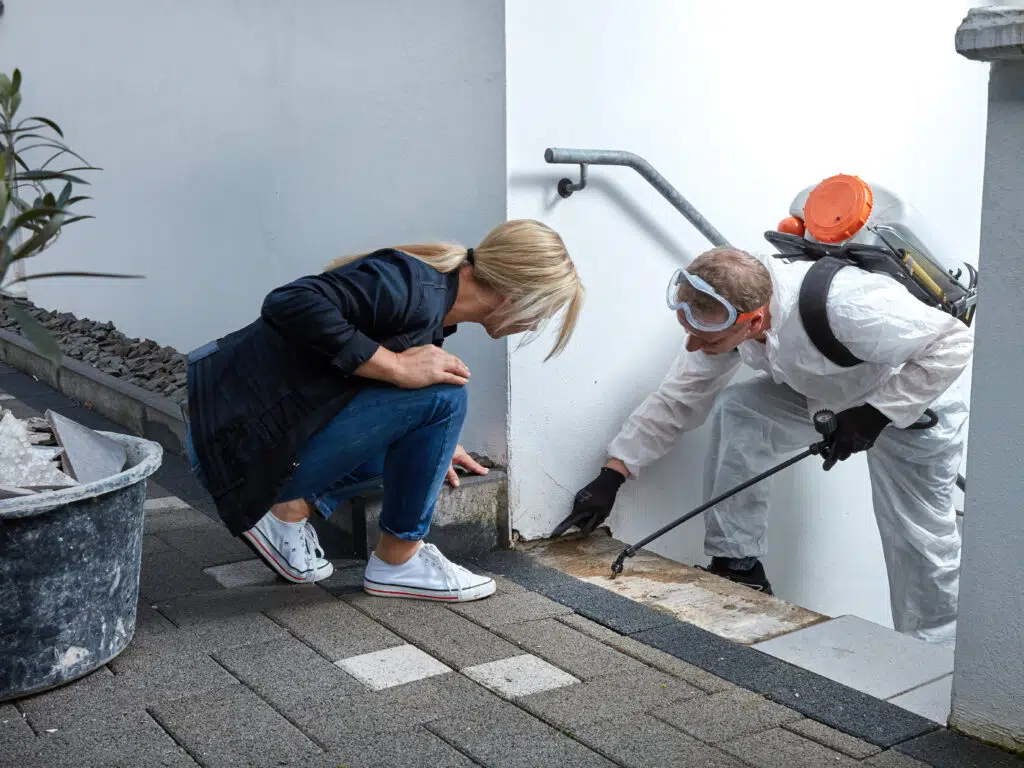Are you struggling with persistent mold growth in your home in the Pacific Northwest? Don’t worry, you’re not alone. The damp climate of this region creates a breeding ground for mold, which can be both unsightly and harmful to your health. But fear not, because we’re here to help you tackle the problem head-on.
In this article, we will delve into the causes of mold growth in the Pacific Northwest and provide you with practical solutions to control humidity levels and prevent moisture buildup in problem areas. You’ll learn about effective techniques for mold removal and how to maintain a mold-free environment moving forward.
Regular inspections and maintenance are also crucial in combating mold, so we’ll emphasize their importance throughout this guide. By following our expert advice, you can take back control of your home’s indoor air quality and ensure a healthier living environment for you and your family.
So let’s get started on your journey towards a mold-free home in the beautiful but humid Pacific Northwest!
Key Takeaways
– Address sources of excess moisture and control humidity levels to prevent mold growth.
– Use dehumidifiers, air conditioners, and proper ventilation to remove excess moisture and prevent mold growth.
– Promptly address leaks and water intrusion to prevent moisture buildup and mold growth.
– Regular inspections, maintenance, and cleaning routines are essential for effective mold prevention and moisture control.
Understanding the Causes of Mold Growth in the Pacific Northwest
If you’re wondering why mold seems to thrive in the Pacific Northwest, we’ve got the answers for you. Mold prevention is crucial in this region due to its abundant moisture and high humidity levels. The combination of frequent rainfall and cool temperatures creates the perfect breeding ground for mold spores to grow and spread.
These microscopic organisms are not only unsightly but also pose serious health risks. Exposure to mold can lead to respiratory problems, allergies, and even infections in individuals with weakened immune systems.
To control humidity levels in your home and prevent mold growth, it’s important to address any sources of excess moisture. This includes fixing leaks, improving ventilation, and using dehumidifiers or air conditioners when necessary. By reducing the amount of moisture in your indoor environment, you can effectively inhibit the growth of mold and protect yourself from its harmful effects.
Moving on to controlling humidity levels in your home…
Controlling Humidity Levels in Your Home
To control humidity levels in your home, there are several key points to consider.
First, using dehumidifiers and air conditioners can help remove excess moisture from the air. These devices work by condensing the water vapor in the air and collecting it.
Second, proper ventilation is crucial in reducing humidity. Opening windows or using exhaust fans can help circulate fresh air and expel dampness.
Lastly, ensuring good air circulation throughout your home is important for preventing stagnant areas where moisture can accumulate. This can be achieved by using ceiling fans or strategically placing fans in areas prone to high humidity.
Using Dehumidifiers and Air Conditioners
When dealing with humidity and moisture in the Pacific Northwest, you can effectively combat these issues by utilizing dehumidifiers and air conditioners to create a drier environment that discourages mold growth.
– Benefits of using dehumidifiers and air conditioners:
– Dehumidifiers remove excess moisture from the air, reducing humidity levels and preventing mold growth.
– Air conditioners not only cool the air but also help to dehumidify it, creating a more comfortable living space.
– Both devices improve indoor air quality by filtering out allergens and pollutants.
– Tips for choosing the right dehumidifier and air conditioner:
– Consider the size of your space to ensure proper functionality.
– Look for energy-efficient models to save on electricity bills.
– Check noise levels if you plan on placing them in bedrooms or living areas.
By incorporating dehumidifiers and air conditioners into your home, you can effectively control humidity levels and reduce moisture, which is crucial for preventing mold. Proper ventilation and air circulation are essential in maintaining a healthy indoor environment.
Proper Ventilation and Air Circulation
Ensuring proper ventilation and air circulation is key to maintaining a healthy indoor environment, keeping your home fresh and comfortable.
Ventilation systems play a crucial role in removing stale air and pollutants while replenishing it with fresh outdoor air. This helps eliminate excess moisture that can lead to mold growth.
One effective way to improve ventilation is by using exhaust fans in high humidity areas, such as bathrooms and kitchens. These fans help remove moist air generated from activities like cooking or showering.
Additionally, opening windows whenever possible allows for natural airflow, helping to reduce humidity levels inside the house.
Regularly cleaning and maintaining ventilation systems is also important for optimal performance and good air quality.
By ensuring proper ventilation, you can prevent moisture buildup in problem areas, which will be discussed in the next section on preventing mold growth.
Preventing Moisture Buildup in Problem Areas
To prevent moisture buildup in problem areas, you need to address leaks and water intrusion. Check for any signs of leaks, such as water stains or dampness, and repair them promptly.
Additionally, properly insulating and sealing vulnerable areas can help prevent moisture from seeping into your home. Ensure that windows, doors, and other openings are tightly sealed, and consider adding insulation to walls and floors to create a barrier against moisture.
Addressing Leaks and Water Intrusion
Addressing leaks and water intrusion is crucial for effective mold removal in the Pacific Northwest, as it can prevent further moisture damage. When dealing with mold issues, it’s important to address any plumbing issues promptly. Leaky pipes or fixtures can lead to excess moisture accumulation, creating an ideal environment for mold growth.
Additionally, repairing roof leaks is essential as they can introduce significant amounts of water into your home, promoting mold development in attic spaces or ceilings. To effectively tackle leaks and water intrusion, start by inspecting all plumbing components and identifying any signs of leakage such as damp spots or discoloration. Promptly repair any damaged pipes or fixtures to prevent ongoing moisture problems.
Likewise, if you notice signs of a roof leak like water stains on ceilings or walls, take immediate action to fix the issue by contacting a professional roofer. By addressing these sources of water intrusion promptly and efficiently, you can mitigate the risk of further moisture damage and create an environment less conducive to mold growth. Properly insulating and sealing vulnerable areas will be discussed in the subsequent section about preventing moisture buildup in problem areas without compromising structural integrity.
Properly Insulating and Sealing Vulnerable Areas
Now that you’ve addressed leaks and water intrusion in your Pacific Northwest home, it’s important to focus on properly insulating and sealing vulnerable areas. By implementing effective insulation techniques and sealing vulnerabilities, you can prevent moisture from seeping into your home, reducing the risk of mold growth.
Here are five key steps to consider:
– Apply spray foam insulation to fill gaps and cracks in walls, ceilings, and floors.
– Install weatherstripping around doors and windows to create a tight seal.
– Seal ductwork with foil tape or mastic to prevent air leakage.
– Use vapor barriers in crawl spaces and attics to block moisture infiltration.
– Insulate pipes to prevent condensation buildup.
By following these techniques, you can create a moisture-resistant barrier within your home. This sets the stage for effectively tackling mold removal techniques in the subsequent section.
Effective Mold Removal Techniques
Tackling humidity and moisture in the Pacific Northwest? You need to know effective mold removal techniques. Mold prevention techniques are crucial in combating the persistent dampness of this region. To effectively remove mold, it’s important to address both surface contamination and airborne spores.
Start by wearing protective gear such as gloves, goggles, and a mask to minimize exposure. Scrub visible mold with a mixture of water and detergent, ensuring thorough coverage. For natural mold removal methods, use vinegar or hydrogen peroxide solutions to kill remaining spores on surfaces.
Additionally, consider using air purifiers or dehumidifiers to reduce moisture levels in indoor spaces. These techniques will help eliminate existing mold growth and prevent its recurrence.
Transitioning into maintaining a mold-free environment requires vigilant monitoring of humidity levels and regular cleaning routines without neglecting hidden areas where moisture can accumulate.
Maintaining a Mold-Free Environment
To maintain a mold-free environment, you’ll want to stay on top of monitoring humidity levels and regularly clean all areas, including those that are often overlooked. Here are four key steps to keep in mind for effective mold prevention and moisture control:
- Control indoor humidity: Keep the relative humidity below 50% by using dehumidifiers or air conditioners in damp areas like basements and bathrooms.
- Ventilate properly: Ensure proper ventilation in high-moisture areas such as kitchens and bathrooms by using exhaust fans or opening windows.
- Fix leaks promptly: Any signs of water damage or leaks should be addressed immediately to prevent moisture buildup that can lead to mold growth.
- Clean and dry affected areas: Regularly clean surfaces prone to moisture accumulation, such as shower walls, sinks, and window sills. Thoroughly dry these areas afterward.
By following these preventive measures, you can significantly reduce the risk of mold growth in your home. Transitioning into the importance of regular inspections and maintenance allows you to proactively identify any potential issues before they worsen.
The Importance of Regular Inspections and Maintenance
Make sure you schedule regular inspections and maintenance to keep your home in tip-top shape and catch any potential issues before they become costly problems. Regular maintenance is essential for preventing mold growth and ensuring a healthy living environment.
It is recommended that you conduct inspections at least once a year, although areas with higher humidity levels may require more frequent checks. During these inspections, pay close attention to areas prone to moisture buildup, such as bathrooms, basements, and crawl spaces. Look for any signs of water damage or leaks, including discoloration on walls or ceilings, musty odors, or warped flooring.
Additionally, ensure proper ventilation in these areas to reduce humidity levels. By conducting regular inspections and promptly addressing any issues found, you can proactively prevent mold growth and maintain a safe and healthy home environment.
Conclusion
In conclusion, tackling humidity and moisture in the Pacific Northwest is crucial to prevent mold growth. By understanding the causes of mold growth and controlling humidity levels, you can maintain a mold-free environment. Preventing moisture buildup in problem areas and using effective mold removal techniques are also important. Regular inspections and maintenance are crucial to identify any potential issues early on. Remember to stay proactive in managing humidity and moisture to protect your home from the harmful effects of mold.
Trust MoldSolutionsNW.com for expert Auburn mold removal services to combat moisture-related issues in the Pacific Northwest.

